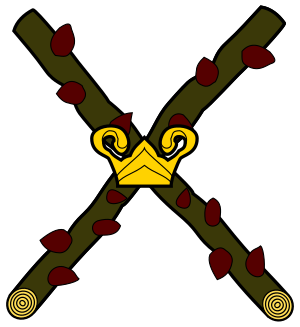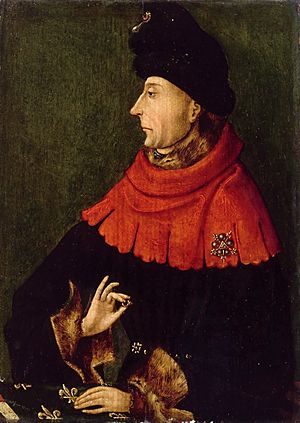Burgundian (party) facts for kids
The Burgundian party was a group of people who supported the Duke of Burgundy during the second half of the Hundred Years' War. They were against the King of France and his supporters, known as the Armagnac party. This disagreement led to a civil war in France in the early 1400s. This civil war was part of the bigger Hundred Years' War.
Contents
Where the Burgundians Lived
The Duke of Burgundy ruled over many lands. These lands stretched from what is now Switzerland all the way to the North Sea. The main area, the Duchy of Burgundy, was given to Philip the Bold in the 1300s. Over time, Philip and his family gained more territories.
These included places like Franche-Comté, Flanders, Artois, and other areas. Today, these lands are part of Belgium, Luxembourg, the Netherlands, and northeastern France. The areas in the Low Countries were very rich. They made a lot of money from making textiles (cloth). This wealth made them want to keep trading with England, which produced a lot of wool.
How the Burgundian Party Started

The term "Burgundian" came from a big fight. This fight was between John the Fearless, the Duke of Burgundy, and Louis I, Duke of Orléans. Louis was the brother of King Charles VI of France. John was the king's cousin.
King Charles VI became mentally ill and could not rule properly. John and Louis both wanted to have power. Their supporters became known as "Burgundians" and "Orleanists."
The Duke of Burgundy had many supporters in Paris. The butchers' guild, a group of butchers, was especially strong in supporting him.
The rivalry between these two groups continued even after John and Louis were gone. In 1407, John the Fearless arranged for Louis of Orléans to be killed. Some people at the University of Paris wrote that this killing was justified. They believed Louis had been planning to harm the king.
After Louis's death, his son Charles, Duke of Orléans became the leader of his party. But the real power went to Charles's father-in-law, Bernard VII, Count of Armagnac. Bernard formed a group against the Burgundians, called the Armagnac party.
Both the Burgundians and the Armagnacs looked for help from England. The Armagnacs made a treaty with the English King Henry IV of England for military help. The Burgundians stayed neutral when the English invaded Normandy. This neutrality led to Charles of Orléans being captured by the English at the Battle of Agincourt in 1415.
In 1418, a Burgundian crowd in Paris killed Bernard VII. After this, the young Dauphin (the king's son) became the leader of the Armagnac party. He moved to Bourges.
After 1418, the Burgundians controlled Paris and the king. But the fighting between the Burgundians and Armagnacs was hurting the war effort against England. Both sides were more focused on fighting each other than on stopping the English.
In 1419, the Duke of Burgundy and the Dauphin tried to make peace. They wanted to focus on fighting the English. However, during a meeting, the Duke of Burgundy was killed by the Dauphin's supporters. This was revenge for Louis of Orléans's murder twelve years earlier.
Alliance with England and Reconciliation
After John the Fearless died, his son Philip the Good became the Duke of Burgundy. Duke Philip then made an alliance with England. The queen, Isabeau, also joined the Burgundian party. Because of their influence, the mentally ill King Charles VI signed the Treaty of Troyes in 1420. This treaty said that Henry V of England would become the next King of France, instead of Charles VI's own son, the Dauphin.
When Henry V and Charles VI both died within months of each other, Henry's young son Henry VI of England became heir to both England and France. Philip the Good and the Burgundians continued to support the English.
However, Philip and the English regent, John of Lancaster, 1st Duke of Bedford, started to disagree. Even though Bedford had married Philip's sister, their relationship became strained. Philip slowly stopped supporting the English. He began to seek peace with the Dauphin, who was now Charles VII of France.
The two sides finally made peace at the Congress of Arras in 1435. This agreement allowed the French king to return to his capital city, Paris.
Important Burgundians
- John the Fearless, a powerful Duke of Burgundy
- Philip the Good, another important Duke of Burgundy
- Jean Petit, a Theologian from the University of Paris
- Nicolas Rolin, the Chancellor (a high-ranking official) of Burgundy
- Simon Caboche, a leading member of the Parisian butcher's guild
- Pierre Cauchon, a Bishop
See also


